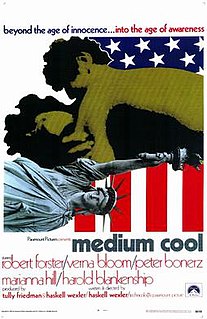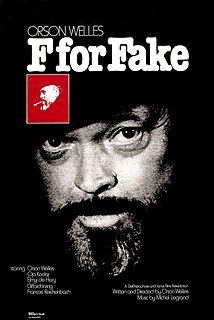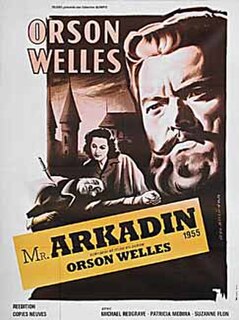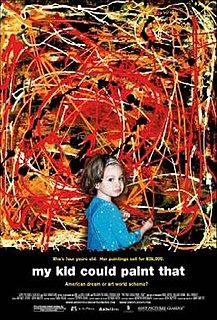
Elephant is a 2003 American psychological drama film written, directed, and edited by Gus Van Sant. It takes place in the fictional Watt High School, in the suburbs of Portland, Oregon, and chronicles the events surrounding a school shooting, based in part on the 1999 Columbine High School massacre. The film begins a short time before the shooting occurs, following the lives of several characters both in and out of school, who are unaware of what is about to unfold. The film stars mostly new or non-professional actors, including John Robinson, Alex Frost, and Eric Deulen.

Medium Cool is a 1969 American drama film written and directed by Haskell Wexler and starring Robert Forster, Verna Bloom, Peter Bonerz, Marianna Hill and Harold Blankenship. It takes place in Chicago in the summer of 1968. It was notable for Wexler's use of cinéma vérité-style documentary filmmaking techniques, as well as for combining fictional and non-fictional content.

F for Fake is a 1973 docudrama film co-written, directed by, and starring Orson Welles who worked on the film alongside François Reichenbach, Oja Kodar, and Gary Graver. Initially released in 1974, it focuses on Elmyr de Hory's recounting of his career as a professional art forger; de Hory's story serves as the backdrop for a meandering investigation of the natures of authorship and authenticity, as well as the basis of the value of art. Far from serving as a traditional documentary on de Hory, the film also incorporates Welles's companion Oja Kodar, hoax biographer Clifford Irving, and Orson Welles as himself. F for Fake is sometimes considered an example of a film essay.

Hiroshima mon amour, the literal English translation of which is "Hiroshima, My Love", is a 1959 French New Wave romantic drama film directed by French film director Alain Resnais and with a screenplay by French author Marguerite Duras. Resnais' first feature-length work, it was a co-production between France and Japan, and documents a series of intensely personal conversations over slightly more than a 24-hour period between an unnamed French actress and Japanese architect. The film is notable for Resnais' innovative use of brief flashbacks to suggest flashes of memory, which create a nonlinear storyline.
Oja Kodar is a Croatian actress, screenwriter and director known as Orson Welles's partner during the later years of his life.

Mr. Arkadin, known in Britain as Confidential Report, is a French-Spanish-Swiss coproduction film, written and directed by Orson Welles and shot in several Spanish locations, including Costa Brava, Segovia, Valladolid and Madrid. Filming took place throughout Europe in 1954, and scenes shot outside Spain include locations in London, Munich, Paris, the French Riviera and at the Château de Chillon in Switzerland.

The Other Side of the Wind is a 2018 film directed, co-written, co-produced and co-edited by Orson Welles, released in 2018 after more than forty years in development. The film stars John Huston, Bob Random, Peter Bogdanovich, Susan Strasberg, and Oja Kodar. Shooting began in 1970 for what Welles intended to be his Hollywood comeback, and resumed on-and-off until 1976. Welles continued to intermittently work on the project into the 1980s, but it became embroiled in legal, financial, and political complications which prevented it from being completed.

Tru Confessions is a 2002 Disney Channel Original Movie directed by Paul Hoen and is based on the book of the same name by Janet Tashjian. Tru Walker aspires to be a famous filmmaker. She has a twin brother Eddie, who is developmentally delayed due to oxygen deprivation at birth. Eddie becomes the subject of Tru's documentary for a film contest she enters.
The Orson Welles Show was an unsold television talk show pilot directed by Orson Welles. It has never been broadcast or released in its entirety. Filming began in September 1978 and the project was completed around February 1979. It ran 74 minutes and was intended for a 90 minute commercial time slot.

Night of the Demons 3 is the third and final film in the Night of the Demons series before the 2009 remake. It was released in 1997 by Paramount Pictures and Republic Pictures in R-Rated and Unrated versions. It stars Amelia Kinkade, Vlasta Vrána, Gregory Calpakis, Tara Slone, Christian Tessier, Joel Gordon, Larry Day, Kristen Holden-Reid, Stephanie Bauder and Patricia Rodriguez. To date it is the only installment in the series that has not been re-released to either home formats or video on demand.

My Kid Could Paint That is a 2007 documentary film by director Amir Bar-Lev. The movie follows the early artistic career of Marla Olmstead, a young girl from Binghamton, New York who gains fame first as a child prodigy painter of abstract art, and then becomes the subject of controversy concerning whether she truly completed the paintings herself or did so with her parents' assistance and/or direction. The film was bought by Sony Pictures Classics in 2007 after premiering at the Sundance Film Festival.
Elisabeth Subrin is a Brooklyn-based filmmaker, screenwriter, and visual artist. She is known for her interdisciplinary practice in the contemporary art and independent film worlds. She is a professor in Temple University's Department of Film and Media Arts. Her feature length narrative film A Woman, a Part; starring Maggie Siff, Cara Seymour, John Ortiz, and Khandi Alexander; premiered at The Rotterdam Film Festival in 2016. She is also the creator of the blog, Who Cares About Actresses, dedicated to actress Maria Schneider.

Prodigal Sons is a 2008 American documentary produced and directed by Kimberly Reed.
Filming 'The Trial' is an unfinished making-of film by Orson Welles, made in 1981, which focuses on the production of his 1962 film The Trial.

U.F.O. is a 2012 British science fiction film about an alien invasion, written and directed by independent British filmmaker Dominic Burns. It stars Bianca Bree, Sean Brosnan and Simon Phillips. U.F.O. was filmed in Crabtree Close, Allestree, Derby.

Dana Spiotta is an American author. Her novel Stone Arabia (2011) was a National Book Critics Circle Award finalist. Her novel Eat the Document (2006) was a National Book Award finalist and won the Rosenthal Foundation Award from the American Academy of Arts and Letters. Her novel Lightning Field (2001) was a New York Times Notable Book of the year. She was a recipient of the Rome Prize in Literature, a Guggenheim Fellowship and a New York Foundation for the Arts Fellowship.

Paola di Gerfalco, Contessa di Gerfalco, better known by her professional name Paola Mori, was an Italian actress and aristocrat, and the third and last wife of Orson Welles.
Carrie Rickey is a feminist American art and film critic. Rickey is the film critic at The Philadelphia Inquirer and often contributes to The New York Times, San Francisco Chronicle and Village Voice.
Beatrice Giuditta Welles is an American former child actress, known for her roles in the film Chimes at Midnight (1966) and the documentary travelogue In the Land of Don Quixote (1964). The daughter of American filmmaker Orson Welles and Italian countess Paola Mori, she is a former model, radio and TV personality, founder of a cosmetics line and designer of handbags and jewelry.

Rolling Thunder Revue: A Bob Dylan Story by Martin Scorsese is a 2019 American pseudo-documentary film, composed of both fictional and non-fictional material, covering Bob Dylan's 1975 Rolling Thunder Revue concert tour. Directed by Martin Scorsese, it is the director's second film on Bob Dylan, following 2005's No Direction Home. The bulk of Rolling Thunder Revue is compiled of outtakes from Dylan's 1978 film Renaldo and Clara, which was filmed in conjunction with the tour.














